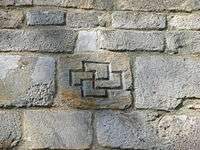Finnish neopaganism

Finnish Neopaganism, or the Finnish native faith (Finnish: Suomenusko: "Finnish Faith") is the contemporary Neopagan revival of Finnish paganism, the pre-Christian polytheistic ethnic religion of the Finns. A precursor movement was the Ukonusko ("Ukko's Faith", revolving around the god Ukko) of the early 20th century. The main problem in the revival of Finnish paganism is the nature of pre-Christian Finnish culture, which relied on oral tradition and of which very little is left.[1] The primary sources concerning Finnish native culture are written by latter-era Christians. They may be biased, tainted or unreliable. The national epic is the Kalevala.
There are two main organisations of the religion, the "Association of Finnish Native Religion" (Suomalaisen kansanuskon yhdistys ry) based in Helsinki and officially registered since 2002,[2] and the "Pole Star Association" (Taivaannaula ry) headquartered in Turku with branches in many cities, founded and officially registered in 2007.[3] The Association of Finnish Native Religion also caters to Karelians[4] and is a member of the Uralic Communion.[5]
History and features
Pagan beliefs, traditions and myths survived for a long time side by side with official Lutheranism in Eastern Finland and in Karelia, at least until the first part of the 20th century.[6] The first efforts of recovery of ancient mythology were carried out to enrich national Finnish culture.[7][8]
Nature worship, respect for traditions, and equality are typical features of the Neopagan movement. The Finnish native religion can be defined as "ethno-pagan", as it is related to national consciousness and identity.[9] Finnish native religion followers do not necessarily consider themselves "Neopagans" or identify with new religions such as Wicca.[10]
They emphasise love for the motherland as a key content of a balanced relationship of humans with nature, old and new generations, as well as individual and community. The Finnish native faith believers hold sacred many unspoiled natural places, woods, springs and rocks.[11] They consider the numinous presence of the gods, the ancestors and the spirits, as pervading the natural sites and environments (hiisi).
In 2013 the Taivaannaula launched a national project on Finnish holy places and sites in order to increase awareness and protection.[12] In 2014 Karhun kansa (People of the Bear) was officially registered as an organised religious community, becoming the first neopagan association given such status in Finland. The status brings the authority for example to marry, bury and give names.[13]
Beliefs
The Finnish native religion is polytheistic, with a pantheon of many deities worshipped: Ukko the sky god, and chief deity in the Finnish pantheon, Akka the goddess of fertility, and wife of Ukko, Ahti, Tapio, Pekko, Nyyrikki, Mielikki, Ilmarinen (the god of sky and weather who some consider to be the same as Ukko), Louhi, Turisas, Haltijas (elven spirits), Lemminkäinen (mythical hero), Väinämöinen (mythical hero, creator god and god of poetry and music and magic), Hiisi (spirit of the holy place, genius loci), Jumi (fertility god or statue that gives fertility).
The religion also includes an element of ancestor worship. For Finnish native religion adherents, the afterlife is a place called Tuonela, and it is a place where several different deities live, including Tuoni.
Festivals
Various traditional festivals are followed, including Hela, a festival celebrating the coming of spring and the new growing season, Juhannus or Ukon juhla, the midsummer festival, Kekri, a celebration of harvest and the ancestors, and Joulu, the midwinter festival.
Some Finnish Neopagans visit sacred forests, where wooden god-images or sacred stones can sometimes be found. Some celebrate the circling of the year at certain dates, for example by burning bonfires, dancing, sacrificing, or making other kinds of rituals. One ritual, which is also an authentic practice of the ancestors, is to drink a toast for the thunder god Ukko at the midsummer festival (Finnish: Ukon juhla).[14]
See also
- Chuvash religion
- Baltic religions
- Slavic religions
Notes
- ↑ Arola 2010, p. 26
- ↑ Uskonnot Suomessa. Suomalaisen kansanuskon yhdistys ry.
- ↑ Uskonnot Suomessa. Taivaannaula ry.
- ↑ Uskonnot Suomessa. Suomalaisen kansanuskon yhdistys ry.
- ↑ Maavalla Koda, "Uralic Communion" section. Quote: «In 10214 (2001) Maavalla Koda together with the representatives of Finnish (Suomen kansanuskon yhdistus ry.), Mari (Osh mari Chi mari and Sorta) and Erzya indigenous religions founded the Uralic Communion. The aim of the Uralic Communion is to establish contacts between different indigenous religions and to contribute to the maintenance and strengthening of these religions.»
- ↑ Pentikäinen 1990
- ↑ Arola 2011
- ↑ Pöyliö 2012
- ↑ Pöyliö 2012
- ↑ Pöyliö 2012
- ↑ Pöyliö 2012
- ↑ Taivaannaula. Hiisien päivä kunnioittaa suomalaisten etnisen uskonnon pyhiä paikkoja.
- ↑ "Friday's papers: Last-minute preparations in Sochi, neo-pagan religion becomes official and an E.coli outbreak in Oulu". Yle.fi. Yle. Retrieved 1 May 2014.
- ↑ Ala-Huissi/HS, 2010
Resources
- Ala-Huissi, Jaana: Maauskoisilla on jääkauden kalenteri. Helsingin Sanomat, 20.3.2010. Sanoma News.
- Arola, Iiro: "Ni sit mä tajusin, et on muitakin kuin minä” – Suomenuskoisten sosiaalinen identiteetti. pro gradu -opinnäytetyö. Helsingin yliopisto/ Teologinen tiedekunta, 2010. Teoksen verkkoversio.
- Arola, Iiro: Suomenuskoiset erottautuvat muista uuspakanoista. Teologia.fi. 21.1.2011.
- Pentikäinen, Juha: Suomalaisen lähtö: Kirjoituksia pohjoisesta kuolemankulttuurista. Suomalaisen Kirjallisuuden Seuran toimituksia 530. Helsinki: Suomalaisen kirjallisuuden seura, 1990. ISBN 951-717-625-2.
- Pöyliö, Venla: Juurilla 8/2012. Turun ylioppilaslehti. Viitattu 11.5.2012.
External links
- Taivaannaula
- Lehto, Finnish organization for earth-based religions